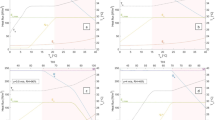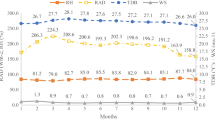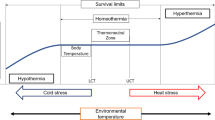Abstract
Global warming seems more probable, whether as gradual warming or increased frequency of warmer episodes. The productivity of cattle in temperate countries will decline unless counteracting steps are adopted. The probability of pre-emptive breeding for maintaining temperate breed performance coupled with heat stress tolerance is too low to be adopted for counteracting warming. The expected warming will mostly involve temperature increases. These will indirectly affect radiant heat gain in animals owing to reduced radiant heat dissipation from the body by convective heat loss, which results in an increased sensitivity to incoming radiant heat at higher air temperatures. These necessitate an emphasis on increasing convective heat loss by structure design and forced air flow by fans. Convective heat loss diminishes with increasing air temperatures. Evaporative heat loss remains the alternative. Evaporative cooling of the ambient requires partial enclosing of the space surrounding the animals and is limited by the humidity in ambient air. An alternative was developed of coupling forced ventilation with wetting of animal surface. The exchange of ambient air flowing on animal surface makes the evaporation practically independent of air humidity and the loss of heat from animal surface practically independent of the surface to air temperature gradient. The coupling of forced ventilation with wetting combination may be attained in various parts of the dairy farm, the holding area of the milking parlour, the feeding trip and the resting area. Each of these requires differing structural and technological adaptations. Climate and farming systems vary between locations which require specific solutions.
Similar content being viewed by others
References
Angrecka S, Herbut P (2016) Impact of barn orientation on insolation and temperature of stalls surface. Ann Anim Sci 16:887–896. https://doi.org/10.1515/aoas-2015-0096
Arave CW, Russev N, Macaulay A (1991) Enclosed vs. open free-stall housing for lactating cows during cold weather. J Dairy Sci 74(Supplement 1):280
Arkin H, Kimmel E, Berman A, Broday D (1991) Heat-transfer properties of dry and wet furs of dairy-cows. Trans ASAE 34:2550–2558
Armstrong DV, VanBaale MJ, Rungruang S, Wuthironarith V, Brouk MJ, Smith JF (2007) Effect of soaking dairy cows at the feed line on animal body temperature in a tunnel ventilated barn equipped with evaporative pads located in a tropical climate, Thailand. J Anim Sci 85:539–539
Berman A (1973) Thermal comfort range in cattle exposed to a near natural climate. In: 3rd Symp Environ. Physiol. Negev Inst. Arid Zone Res., Beer-Sheva, Israel, Int. J. Biometeorol 1:88–89
Berman A (2004) Tissue and external insulation estimates and their effects on prediction of energy requirements and of heat stress. J Dairy Sci 87:1400–1412
Berman A (2006) Extending the potential of evaporative cooling for heat-stress relief. J Dairy Sci 89:3817–3825
Berman A (2009) Predicted limits for evaporative cooling in heat stress relief of cattle in warm conditions. J Anim Sci 87:3413–3417
Berman A (2010) Forced heat loss from body surface reduces heat flow to body surface. J Dairy Sci 93:242–248. https://doi.org/10.3168/jds.2009-2601
Berman A (2011) Invited review: are adaptations present to support dairy cattle productivity in warm climates? J Dairy Sci 94:2147–2158. https://doi.org/10.3168/jds.2010-3962
Berman A (2014) Inter-animal radiation as potential heat stressor in lying animals. Int J Biometeorol 8:1683–1691. https://doi.org/10.1007/s00484-013-0712-5
Berman A, Horovitz T (2012) Radiant heat loss, an unexploited path for heat stress reduction in shaded cattle. J Dairy Sci 95:3021–3031
Berman A, Meltzer A (1973) Critical temperatures in lactating dairy cattle: a new approach to an old problem. Int J Biometeorol 17:167–176
Berman A, Morag M (1971) Nychthemeral patterns of thermoregulation in high producing cows in a hot-dry near-natural climate. Aust J Agric Res 22:671–680
Berman A, Wolfenson D (1987) Physiological limitations to dairy production in the subtropical climate of Israel. In: Samueloff SaY MK (ed) Adaptive physiology to stressful environments. CRC Press, Baton Rouge
Berman A, Amir S, Volcani R (1963) The relationship between the rate of heat production and the level of milk production in a subtropical climate. Aust J Agric Res 16(874–81):874–881
Berman A, Folman Y, Kaim M, Mamen M, Herz Z, Wolfenson D, Arieli A, Graber Y (1985) Upper critical temperatures and forced ventilation effects for high yielding cows in a subtropical climate. J Dairy Sci 68:1488–1495
Blake RW, McDaniel BT, Pearson RE, McDowell RE, Wilcox CJ (1986) Genetic methods of improving dairy cattle for the south: a review and prospects from regional project S-49. J Dairy Sci 69:1098–1109
Branton C, McDowell RE, Brown MA (1966) Zebu-European crossbreeding as a basis of dairy cattle improvement in the U.S.A. Southern Coop. Ser.Bull. Louisiana State Univ., Baton Rouge, p 114
Brosh A, Henkin Z, Ungar ED, Dolev A, Shabtay A, Orlov A, Yehuda Y, Aharoni Y (2010) Energy cost of activities and locomotion of grazing cows: a repeated study in larger plots. J Anim Sci 88:315–323. https://doi.org/10.2527/jas.2009-2108
Brown WH, Fuquay JW, Mcgee WH, Iyengar SS (1974) Evaporative cooling for Mississippi dairy-cows. Trans ASAE 17:513–515
Brown-Brandl TM, Chitko-McKown CG, Eigenberg RA, Mayer JJ, Welsh TH, Davis JD, Purswell JL (2017) Physiological responses of feedlot heifers provided access to different levels of shade. Animal 11:1344–1353
Bucklin RA, Bottcher RW, GLv W, Czarick M (1993) Reflective roof coatings for heat stress relief in livestock and poultry housing. Appl Eng Agric 9:123–129
Buffington DE, Collier RJ, Canton GH (1983) Shade management systems to reduce heat stress for cows in hot humid climates. Trans ASAE 26:1798–1802
Calegari F, Calamari L, Frazzi E (2016) Cooling systems of the resting area in free stall dairy barn. Int J Biometeorol 60:605–614. https://doi.org/10.1007/s00484-015-1056-0
da Silva RG, Guilhermino MM, de Morais DAEF (2010) Thermal radiation absorbed by dairy cows in pasture. Int J Biometeorol 54:5–11. https://doi.org/10.1007/s00484-009-0244-1
Dikmen S, Khan FA, Huson HJ, Sonstegard TS, Moss JI, Dahl GE, Hansen PJ (2014) The SLICK hair locus derived from Senepol cattle confers thermotolerance to intensively managed lactating Holstein cows. J Dairy Sci 97:5508–5520
Eigenberg RA, Brown-Brandl TM, Nienaber JA (2010) Shade material evaluation using a cattle response model and meteorological instrumentation. Int J Biometeorol 54:601–607. https://doi.org/10.1007/s00484-010-0381-6
Flamenbaum I, Galon N (2010) Management of Heat Stress to improve fertility in dairy cows in Israel. J Reprod Dev 56:S36–S41
Flamenbaum I, Berman A, Wolfenson D (1984) Summer effect on milk production and conception rate of high yielding dairy cows in Israel and its alleviation. Paper presented at the 35th Ann. Meeting EAAP, The Hague, Netherlands
Flamenbaum I, Wolfenson D, Mamen M, Berman A (1986) Cooling dairy cattle by a combination of sprinkling and forced ventilation and its implementation in the shelter system. J Dairy Sci 69:3140–3147
Folman Y, Berman A, Herz Z, Kaim M, Rosenberg M, Mamen M, Gordin S (1979) Milk yield and fertility of high-yielding dairy cows in a sub-tropical climate during summer and winter. J Dairy Res 46:411–425
Ittner NR, Kelly CF (1951) Cattle shades. J Anim Sci 10:184–194
Kelly CF, Ittner NR, Bond TE (1948) Artificial shades for livestock in hot climates. Agric Eng 29:239–246
Kelly CF, Bond TE, Ittner NR (1950) Thermal design of livestock shelters. Agric Eng 31:601–606
Khongdee S, Sripoon S, Chousawai S, Hinch G, Chaiyabutr N, Markvichitr K, Vajrabukka C (2010) The effect of modified roofing on the milk yield and reproductive performance of heat-stressed dairy cows under hot-humid conditions. Anim Sci J 81:606–611. https://doi.org/10.1111/j.1740-0929.2010.00771.x
McDowell RE, Wilk JC, Talbott CW (1996) Economic viability of crosses of Bos taurus and Bos indicus for dairying in warm climates. J Dairy Sci 79:1292–1303
Nardone A, Ronchi B, Lacetera N, Ranieri MS, Bernabucci U (2010) Effects of climate changes on animal production and sustainability of livestock systems. Livestock Sci 130:57–69. https://doi.org/10.1016/j.livsci.2010.02.011
NRC (2001) Nutrient requirements of dairy cattle / subcommittee on dairy cattle nutrition, committee on Animal Nutrition, Board on Agriculture, 7th edn. National Research Council, National Academy of Sciences
Oliveira SEO, Costa CCD, de Souza JBF, de Queiroz JPAF, Maia ASC, Costa LLD (2014) Short-wave solar radiation level willingly tolerated by lactating Holstein cows in an equatorial semi-arid environment. Trop Anim Health Prod 46:1413–1417. https://doi.org/10.1007/s11250-014-0657-7
Ornes S (2018) Core concept: how does climate change influence extreme weather? Impact attribution research seeks answers. PNAS 115(33):8232–8235
Ortiz XA, Smith JF, Bradford BJ, Harner JP, Oddy A (2011) Effect of complementation of cattle cooling systems with feedline soakers on lactating dairy cows in a desert environment. J Dairy Sci 94:1026–1031. https://doi.org/10.3168/jds.2010-3126
Palacio S, Bergeron R, Lachance S, Vasseur E (2015) The effects of providing portable shade at pasture on dairy cow behavior and physiology. J Dairy Sci 98:6085–6093. https://doi.org/10.3168/jds.2014-8932
Shoshani E, Hetzroni A (2013) Optimal barn characteristics for high-yielding Holstein cows as derived by a new heat-stress model. Animal 7:176–182
Talbott CW, Zaman MZ, McDowell RE, McDaniel BT (1998) Potential to increases milk yield in tropical countries with indigenous dairy cattle: the Sahiwal model. J Dairy Sci 81(SUPPL. 1):140
Thiagarajan M, Thomas CK (1991) Housing effects on crossbred cows in hot-humid climate. Indian J Anim Sci 61:1222–1225
Wolfenson D, Flamenbaum I, Berman A (1988a) Dry period heat stress relief effects on prepartum progesterone, calf birth weight and milk production. J Dairy Sci 71:809–818
Wolfenson D, Flamenbaum I, Berman A (1988b) Hyperthermia and body energy store effects on estrous behaviour, conception rate, and corpus luteum function in dairy cows. J Dairy Sci 71:3497–3504
Wright NC (1954) The ecology of domesticated animals. In: Hammond J (ed) Progress in the physiology of farm animals, vol 1. Butterworths Publications, Ltd., London, pp 191–251
Author information
Authors and Affiliations
Corresponding author
Rights and permissions
About this article
Cite this article
Berman, A. An overview of heat stress relief with global warming in perspective. Int J Biometeorol 63, 493–498 (2019). https://doi.org/10.1007/s00484-019-01680-7
Received:
Revised:
Accepted:
Published:
Issue Date:
DOI: https://doi.org/10.1007/s00484-019-01680-7




